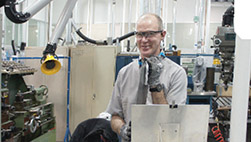by Douglas Nelms
 “The high level of safety achieved in scheduled airline operations lately should not obscure the fact that most of the accidents that occurred could have been prevented. This suggest that in many instances, the safety measures already in place may have been inadequate, circumvented or ignored.”
“The high level of safety achieved in scheduled airline operations lately should not obscure the fact that most of the accidents that occurred could have been prevented. This suggest that in many instances, the safety measures already in place may have been inadequate, circumvented or ignored.”
ICAO Accident Prevention Manual, 1984
Quite likely, the saddest words in aviation are: “This accident could have been prevented.” Unfortunately, they are also among the most common.
There are a lot of different reasons for preventable accidents — mechanical failure caused by a mechanic’s error among the most prevalent. It’s a known fact — and virtually every aviation organization worldwide has some form of maintenance safety forum aimed at preventing those errors. So lack of knowledge is not the problem.
The problem is that we keep making the same mistakes.
In June 1990, a British Airways maintenance night shift manager decided to install a windscreen in a BAC-111 by himself. Without properly studying the maintenance manual and ignoring the advice of the stores supervisor, he installed the windscreen using bolts that were fractionally smaller (0.66 mm) than the required bolt. On a final maintenance check, no one caught the fact that there was an excessive amount of countersink left unfilled by the bolt heads. On climb out the next day, the windscreen blew out, pulling the pilot partially out of the cockpit.
In August 1985, the world’s worst single-aircraft accident occurred when a Japan Airlines Boeing 747 crashed into a mountain, killing all 520 individuals on board. When the aircraft reached its cruising altitude of 24,000 ft., the rear pressure bulkhead failed, causing sudden decompression and loss of control of most of the vertical stabilizer and rudder. The subsequent investigation determined that years prior to the crash, the aircraft had sustained a tail scrape. The repair to the scrape included replacing the lower half of the bulkhead. This was spliced to the upper half incorrectly, using only a single row of rivets instead of three rows. The aircraft then flew over 12,000 flights and underwent six C checks without the error being found prior to the crash.
On December 7, 2011, an AS350-B2 helicopter operated by Sundance Helicopters crashed just outside Las Vegas, NV, killing the pilot and four passengers. An NTSB study showed the cause being the use of a degraded self-locking nut and improper, or lack of, installation of a split pin. The NTSB also found inadequate post maintenance inspection.
We learn from our mistakes, and can repeat them exactly.
Maintainers are human. They make mistakes. Fortunately, in the vast majority of instances, the mistake is either minor and proves to be of no consequence, the maintainer catches his or her own mistake, or it is spotted in the post-maintenance inspection and corrected.
Unfortunately, as in the cases above, mistakes are not always minor and they
are not always subsequently caught and corrected.
“While we have advanced leaps and bounds in many areas in aviation safety, when you look at the maintenance and engineering arena, not much has changed since the 1930s and 40s,” said Rudy Quevedo, formerly Director of Global Programs for the Flight Safety Foundation and now Director of Safety for IATA. “We’ve talked a lot in recent years about the things that caused the accidents in those days, issues such as human factors. But the fact is that we keep having the same issues.”
One of the biggest human factors issues is the problem of complacency – not following proper procedure…the ‘I’ve done this a thousand times. Why do I need to look
at the manual’ syndrome.
[s2If is_user_logged_in()]
<a href=”http://avm-mag.com/aviation-maintenance-magazine” target=”_blank”>READ FULL STORY >>></a>
[/s2If]
[s2If is_user_not_logged_in()]
[message_box title=”To READ the full article in our digital edition you need to be a registered subscriber to the magazine – If you are NOT then goto the SUBSCRIBE section of the site first before you can login” color=”green”]
<div>[login-shortcode]</div>
[/message_box]
[/s2If]